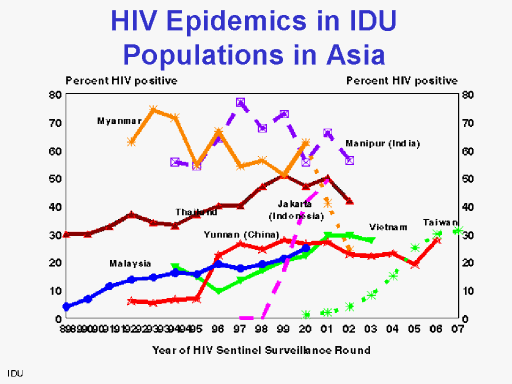| front |1 |2 |3 |4 |5 |6 |7 |8 |9 |10 |11 |12 |13 |14 |15 |16 |17 |18 |19 |20 |21 |22 |23 |24 |25 |26 |27 |28 |29 |30 |31 |32 |33 |review |
 |
The global war
on drugs clearly has not been successful: illicit drug
use has been increasing in most countries throughout the
world during the past two decades. This increase,
especially in injecting drug users (IDU), has coincided
with the global spread of HIV. In whatever country HIV
may be present, the potential for HIV to be introduced
into IDU networks increases.
As of 2007, there have been more than 100
documented HIV epidemics in IDU networks throughout the
world. Since the
mid-1980s, explosive spread of HIV in IDU networks in
the Asia-Pacific (AP) region have occurred in India,
Myanmar, Thailand, Malaysia, Pakistan, China, Vietnam,
Nepal, Indonesia, and most recently in Taiwan.
This figure, prepared for a WHO report in 2003,
showed HIV prevalence trends in seven IDU epidemics in
the AP region up to 2003.
The most recent IDU epidemic in Taiwan was just
added. Many of
these HIV epidemics started in the mid-to-late-1980s and
most have shown no sign of any significant decrease in
over a decade.
The estimates for the Taiwan IDU epidemic should be more
accurately classified as “guesstimates” since the
available data from Taiwan are not sufficient to provide
reliable estimates of the size of the IDU population or
the prevalence of HIV in the total IDU population. Such
paucity of reliable data results in a general tendency
to overestimate both the size of IDU populations as well
as the actual HIV prevalence in IDU populations.
This general problem is probably applicable to
the current HIV epidemics in IDU populations in many
Eastern European countries!
|